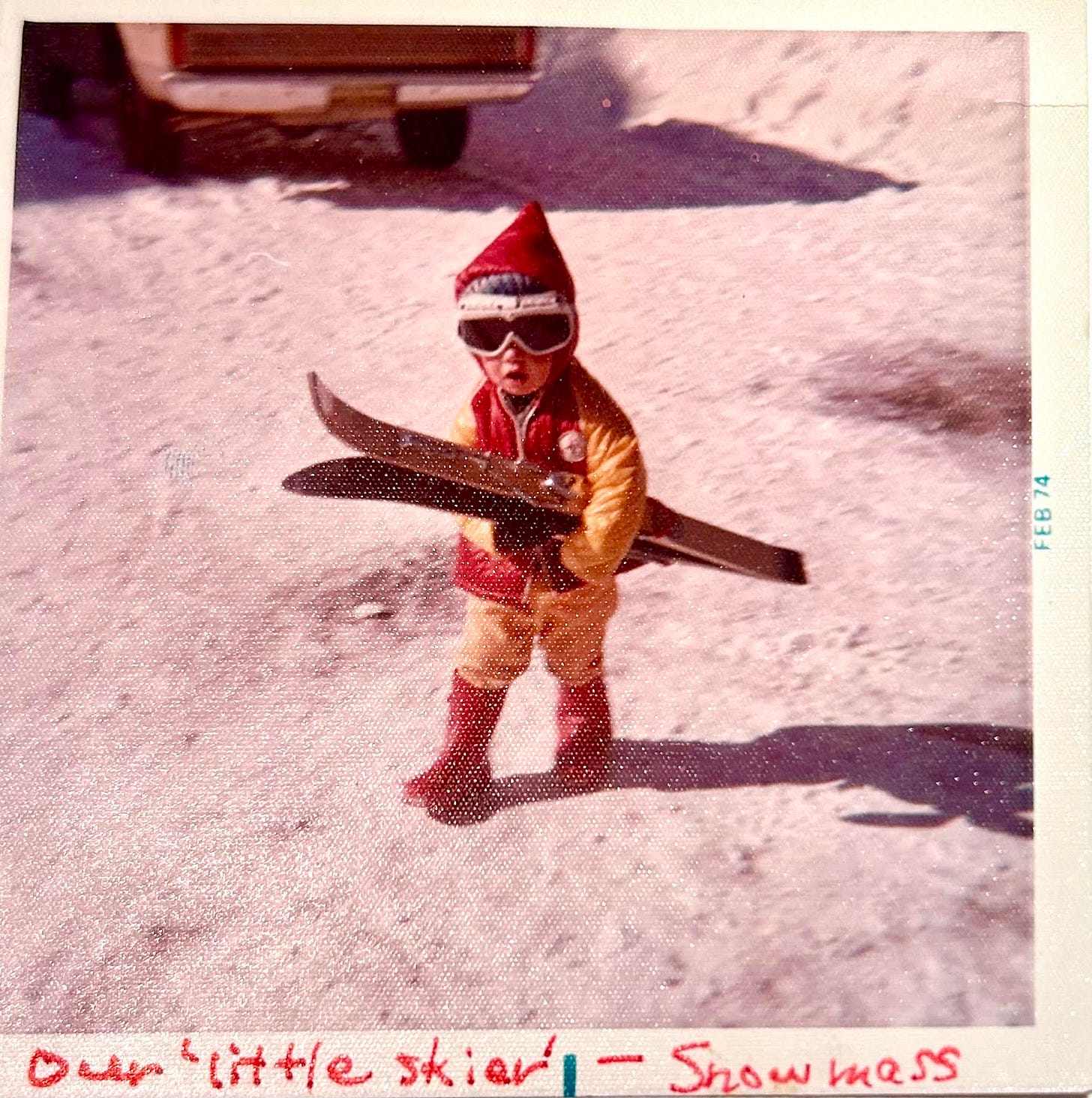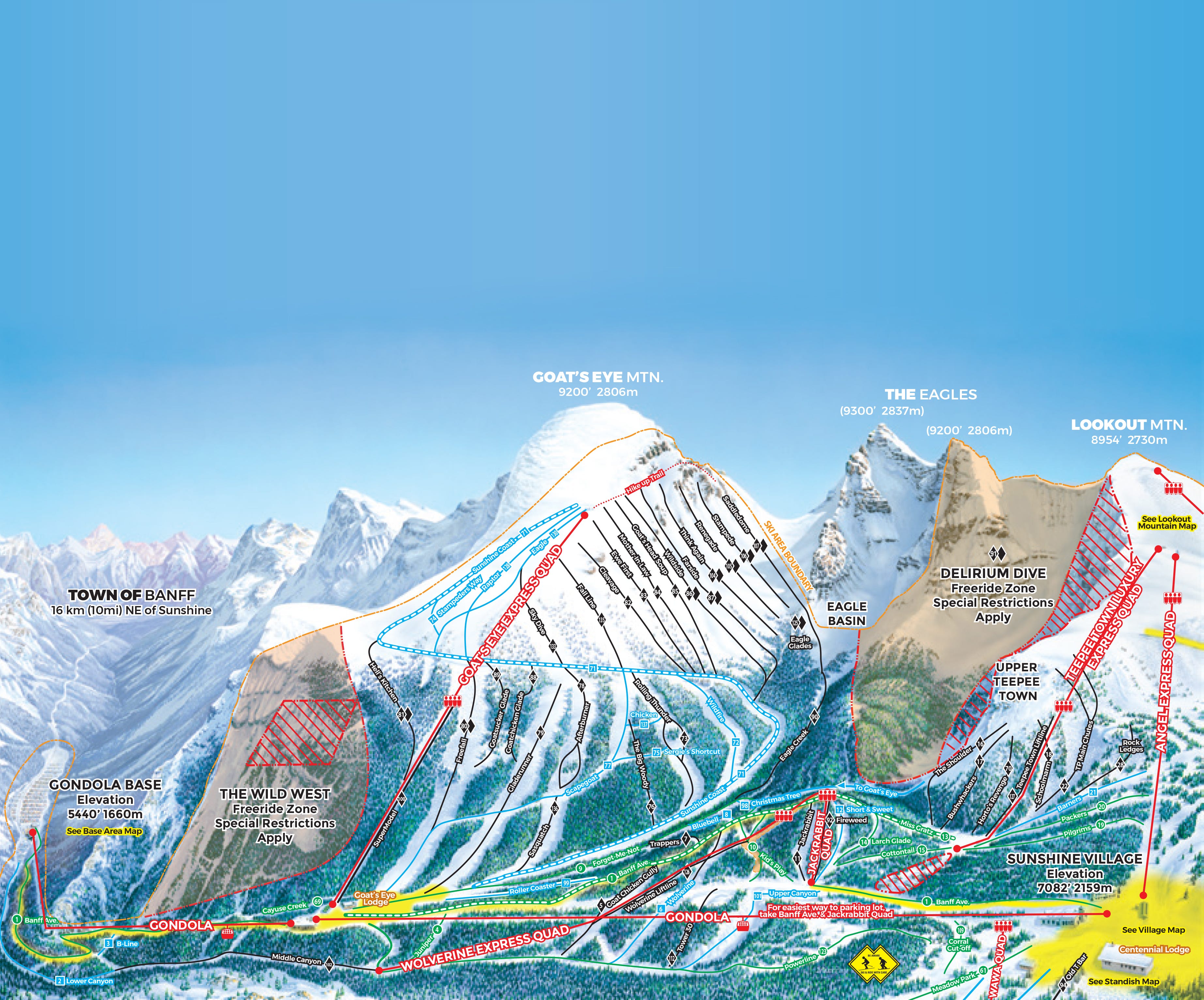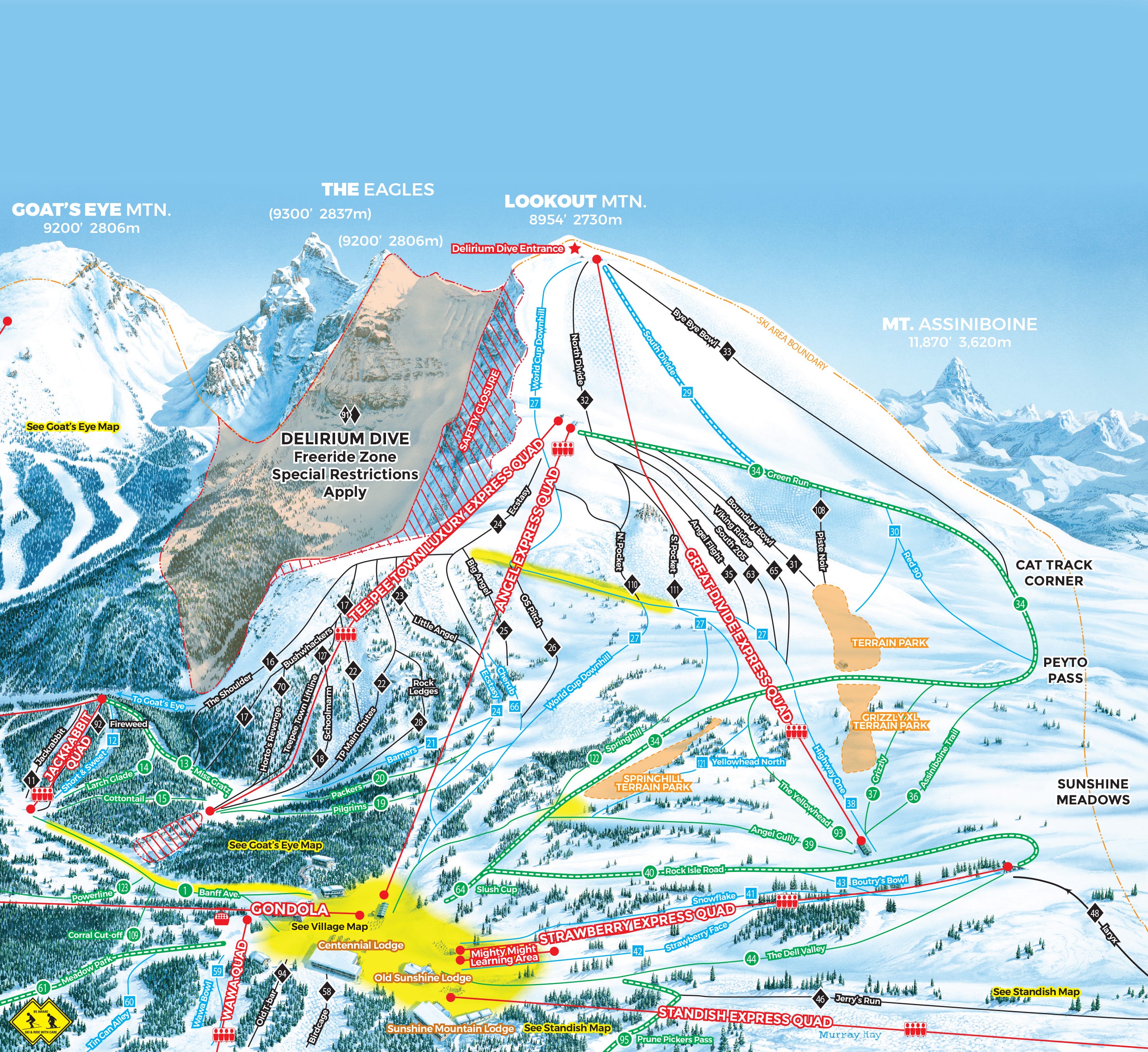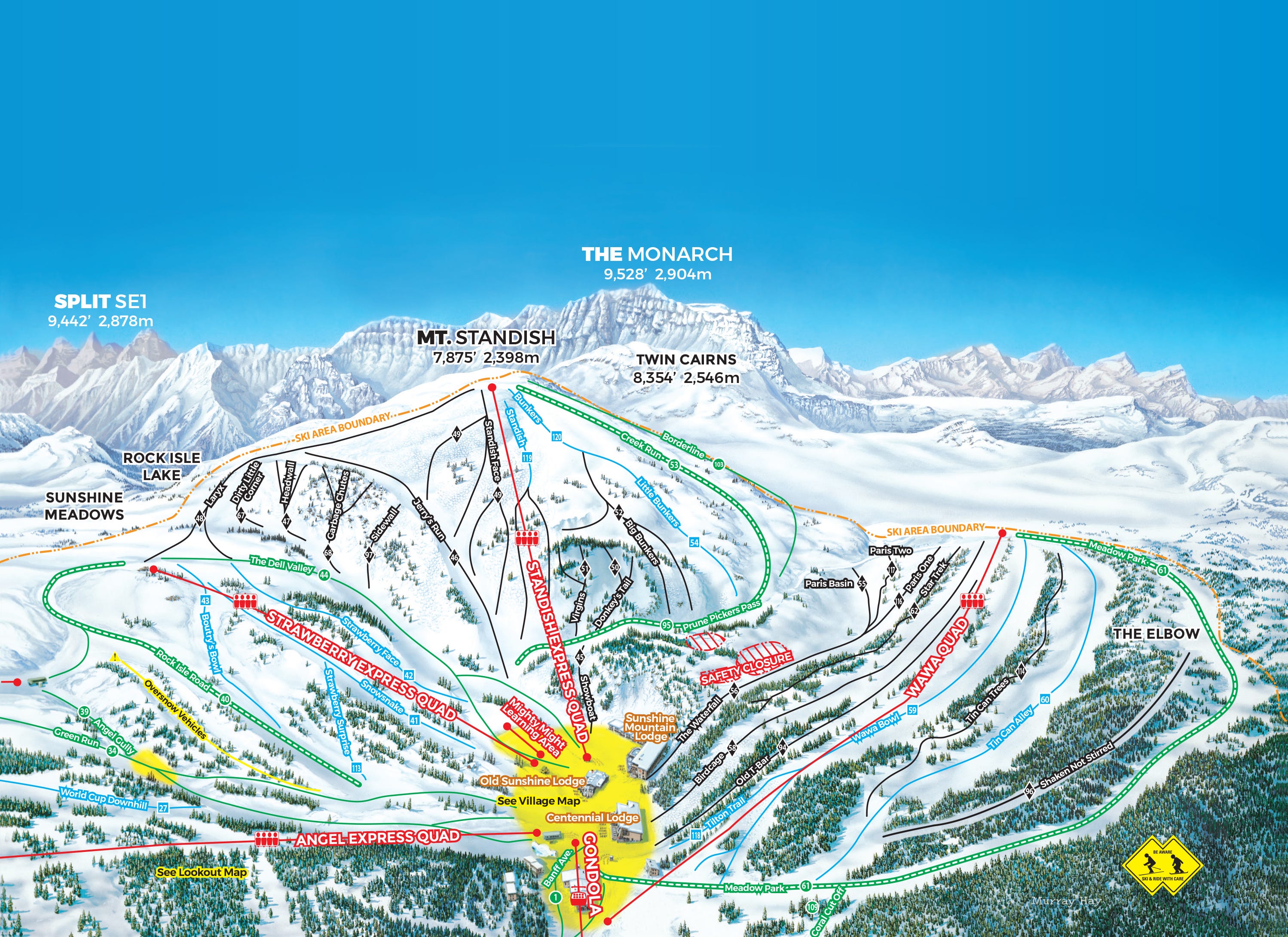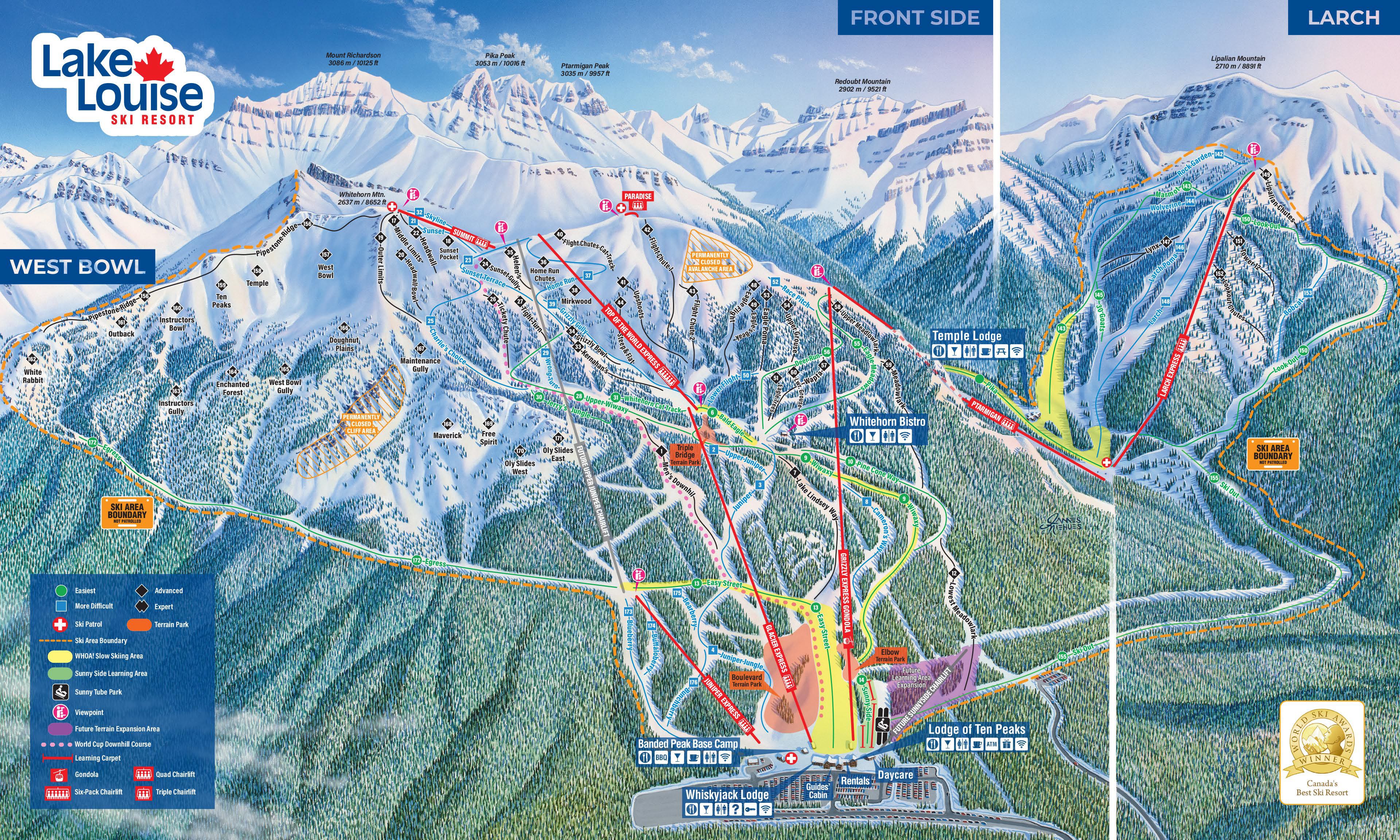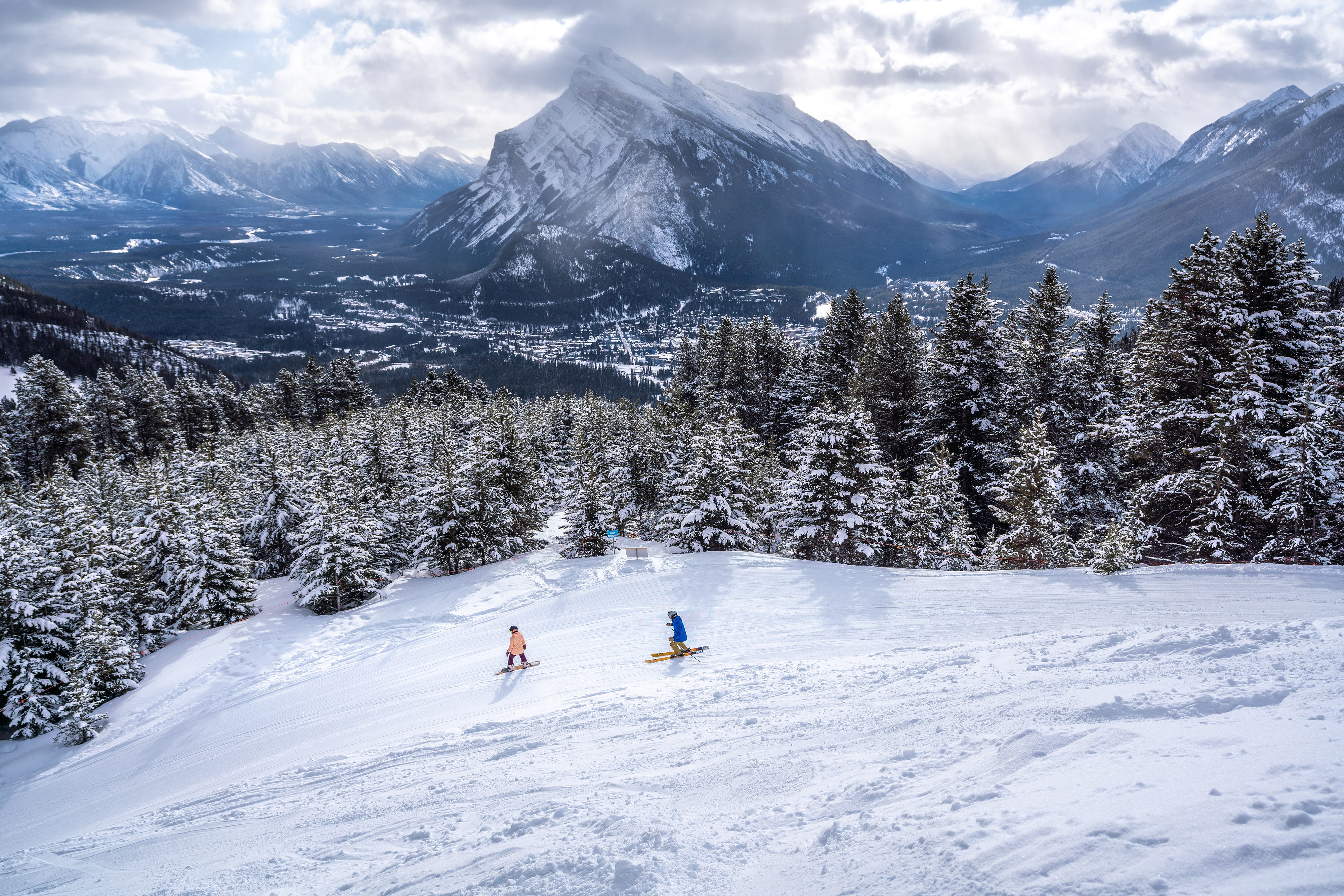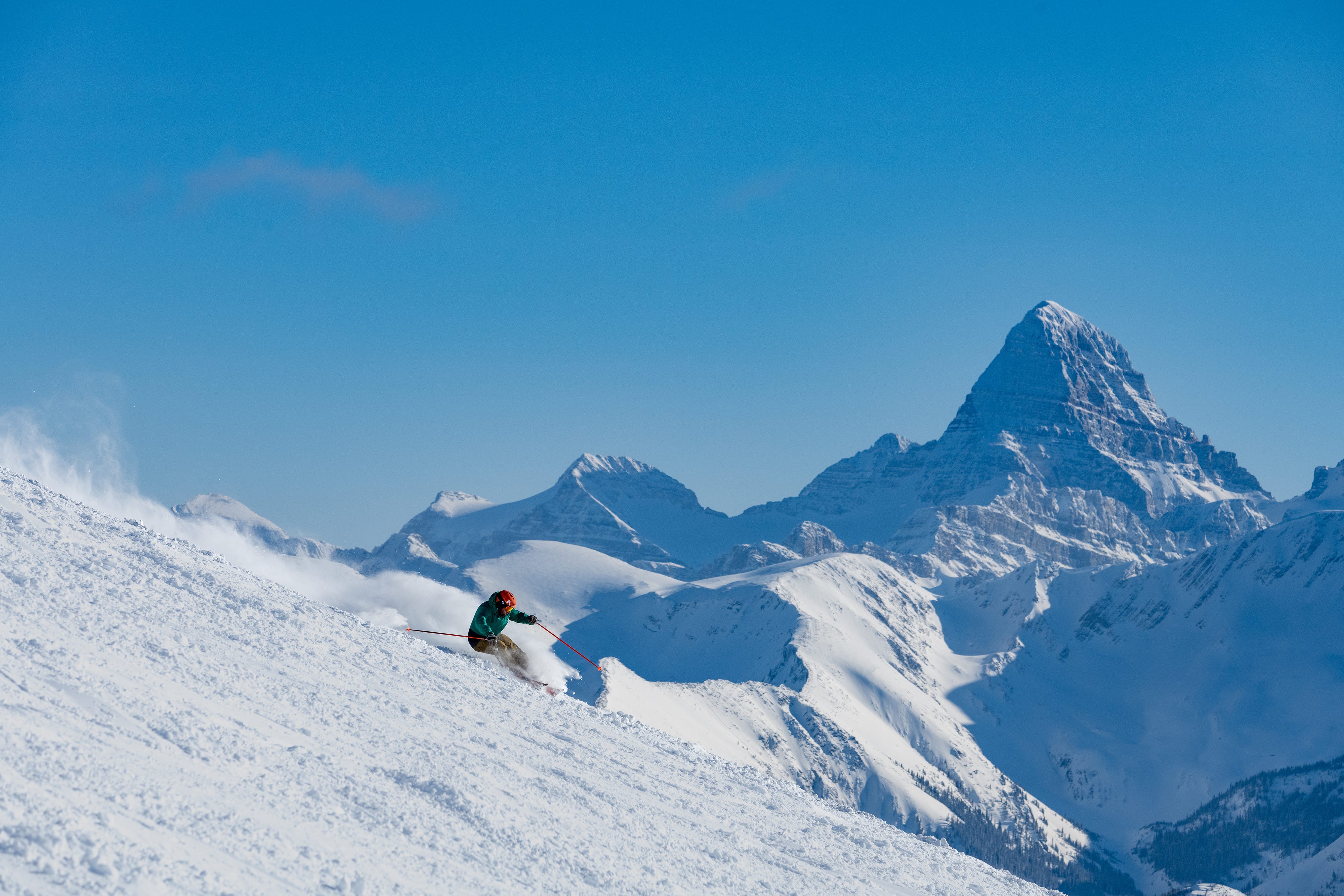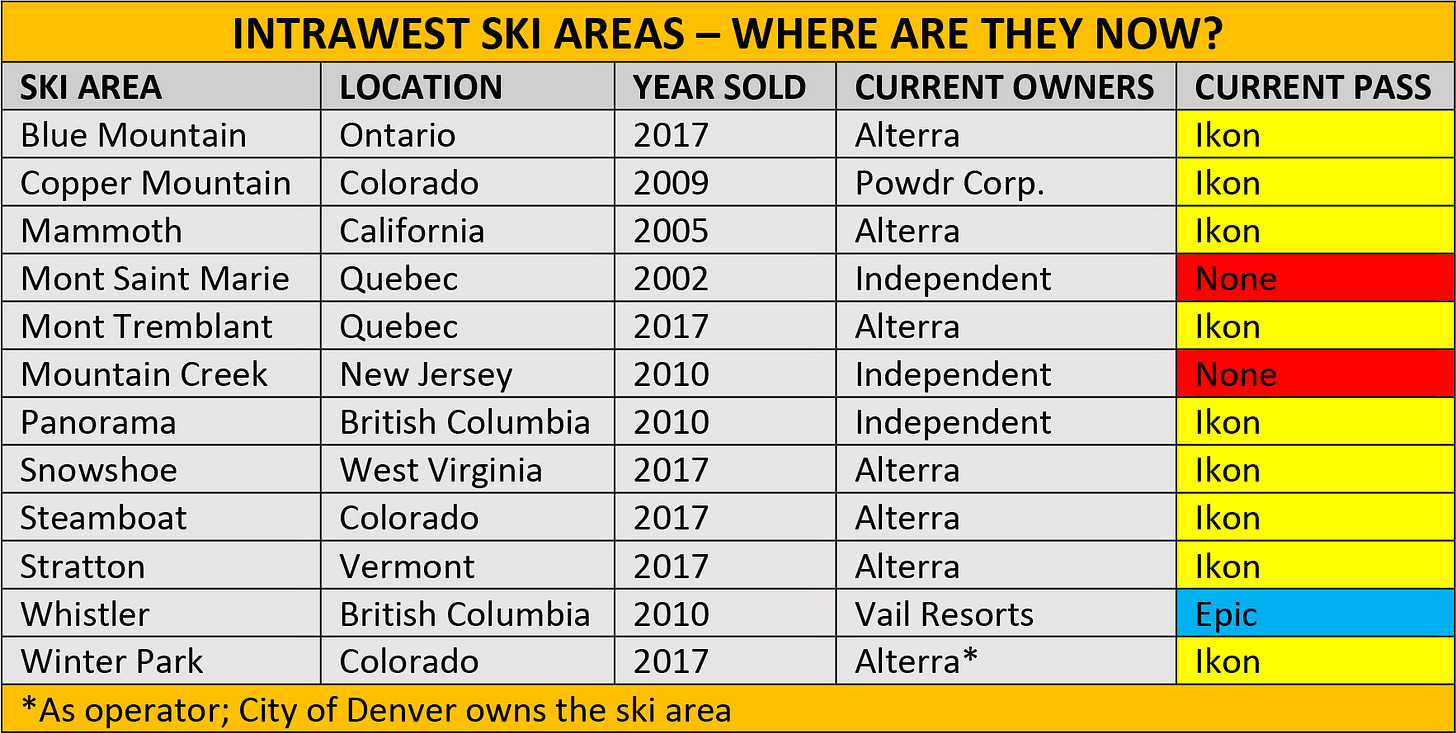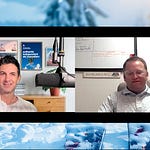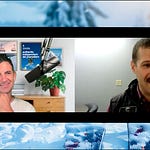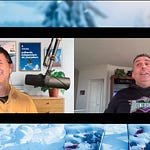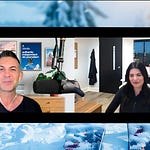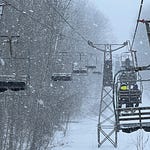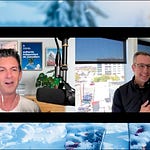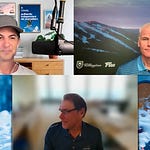Who
Pete Woods, President of SkiBig3, the umbrella organization for Banff Sunshine, Lake Louise, and Mt. Norquay, Alberta
Recorded on
May 4, 2023
About SkiBig3
SkiBig3 “works in conjunction with all three ski resorts within Banff National Park to allow you access to everything this winter destination has to offer,” according to the organization’s LinkedIn page. Each ski area – Banff Sunshine, Lake Louise, and Mt. Norquay – is independently owned and operated.
Banff Sunshine
Click here for a mountain stats overview
Owned by: Ralph, Sergei, and John Scurfield
Located in: Sunshine Village, Alberta
Year founded: Sometime in the 1930s
Pass affiliations: Ikon Pass: 5 or 7 combined days with Lake Louise and Mt. Norquay; Mountain Collective: 2 days
Closest neighboring ski areas: Norquay (23 minutes), Sunshine (41 minutes), Nakiska (1 hour) - travel times vary considerably depending upon weather and time of day.
Base elevation: 5,440 feet
Summit elevation: 8,954 feet
Vertical drop: 3,514 feet
Skiable Acres: 3,358
Average annual snowfall: 360 inches
Trail count: 137 (25% advanced/expert, 55% intermediate, 20% beginner)
Lift count: 12 (1 gondola, 7 high-speed quads, 2 fixed-grip quads, 2 carpets - view Lift Blog’s inventory of Sunshine’s lift fleet)
Sunshine chops its trailmap into three pieces on its website. This is slightly confusing for anyone who isn’t familiar with the ski area and doesn’t understand how the puzzle pieces fit together. I’ve included those three maps below, but they’ll make more sense in the context of this 2010 trailmap:
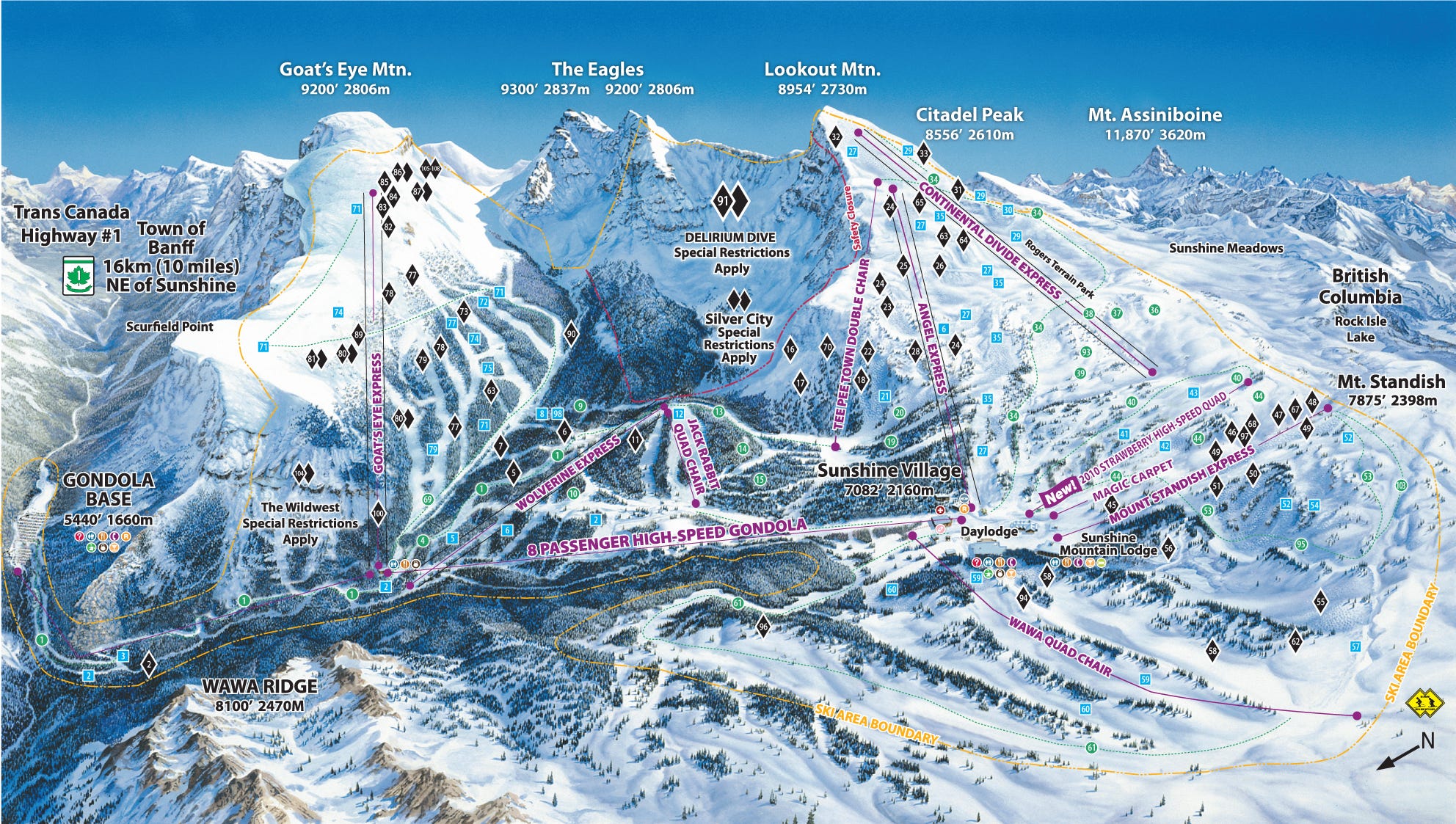
Sunshine’s current maps:
Lake Louise
Click here for a mountain stats overview
Owned by: Charlie Locke (he first owned the ski area from 1981 to 2003, then sold it to Resorts of the Canadian Rockies, and re-bought it from them in 2008)
Located in: Lake Louise, Alberta
Year founded: 1954
Pass affiliations: Ikon Pass: 5 or 7 combined days with Banff Sunshine and Mt. Norquay; Mountain Collective: 2 days
Closest neighboring ski areas: Sunshine (41 minutes), Norquay (44 minutes), Nakiska (1 hour, 22 minutes) - travel times vary considerably depending upon weather and time of day.
Base elevation: 5,400 feet
Summit elevation: 8,650 feet
Vertical drop: 3,250 feet
Skiable Acres: 4,200
Average annual snowfall: 179 inches
Trail count: 164 (30% advanced/expert, 45% intermediate, 25% beginner)
Lift count: 11 (1 gondola, 1 six-pack, 3 high-speed quads, 2 fixed-grip quads, 1 triple, 3 carpets - view Lift Blog’s inventory of Lake Louise’s lift fleet)

Mt. Norquay
Click here for a mountain stats overview
Owned by: Adam and Janet Waterous
Located in: Improvement District No. 9, Alberta
Year founded: 1926
Pass affiliations: Ikon Pass: 5 or 7 combined days with Banff Sunshine and Lake Louise
Closest neighboring ski areas: Sunshine (23 minutes), Lake Louise (43 minutes), Nakiska (54 minutes) - travel times vary considerably depending upon weather and time of day.
Base elevation: 5,350 feet
Summit elevation: 6,998 feet
Vertical drop: 1,650 feet
Skiable Acres: 190
Average annual snowfall: 120 inches
Trail count: 60 (44% advanced/expert, 25% intermediate, 31% beginner)
Lift count: 6 (1 high-speed quad, 2 fixed-grip quads, 1 double, 2 carpets - view Lift Blog’s inventory of Mt. Norquay’s lift fleet)

Why I interviewed him
There are places that make sense, and places that just don’t. Lakes and grocery stores and movie theaters and sand dunes and pizza places and interstate highways. As a U.S. American, these things always squared with my worldview. Then I stepped out of the car in New York City at age 19 and I’m like what the actual fuck is happening here? A vertical human swarm in a sprawling sideways nation. Or to take another example: cornfields and baitshops and gas stations and forests. As a Midwesterner I could understand those things. But then Lord of the Rings dropped and I was like what planet did they shoot this on and then I was like OK I guess that’s New Zealand.
Arriving in Banff is like that. Most visitors travel there via Calgary. Nothing against Calgary, but I’m not sure it’s a place that most of us go to on purpose. Skiers drop into the airport, leave the city, drive west. Flat forever. Then, suddenly, you are among mountains. Not just mountains, but the most amazing mountains you’ve ever seen, striated goliaths heaving skyward like something animate and immensely powerful, spokes of a great subterranean machine primed to punch through the earth like invaders from Cybertron.
Here, so surrounded, you arrive in Banff National Park. Within its boundaries: two towns, three ski areas. The towns are tight, walkable, lively, attractive. None of the hill-climbing megamansion claptrap that clutters the fringes of so many U.S. ski towns. Just a pair of glorious grand hotels airlifted, it seems, from the Alps. Two of the ski areas are Summit County scale, with lift plants and trail footprints to match Breck or Keystone or Copper. The third is a quirky locals’ bump with mogul fields studded like cash crops up the incline. All framed by those wild mountains.
It feels sort of European and sort of fantasyland Rockies and sort of like nothing else on Earth. It is, at the very least, like nothing else in North America. The texture here is rich. Banff’s most commonly cited attribute is its beauty. The most consistent point against is relatively low snowfalls compared to, say, SkiBig3’s Powder Highway neighbors or Whistler. But there is so much in between those gorgeous views and that modest snowfall that makes these three mountains one of the continent’s great ski destinations.
Like the towns themselves. In many ways, this is Canadian Aspen, with its multiple mountains knitted via shuttlebus, rich cuisine, walkable mountain villages. In other ways, it is what Aspen could have been. You have to work in Banff National Park to live there – that’s the law. The richness that adds to the community is incalculable. Imagine a Colorado so built? No second homes, no runaway short-term rental market. The ripple effects on traffic, on cost, on mood and energy are tangible and obvious. This is a place that works.
It’s not the only place that works, of course. And many of Banff’s bedrock operating principles would not be culturally transferable to the south. Including, perhaps, the spirit of bonhomie that unites three independently owned, competing ski areas under a single promotional umbrella called SkiBig3. Remember when Vail yanked its Colorado resorts out of Colorado Ski Country USA because the company didn’t want its dues to support competitors’ marketing? What’s happening in Banff is the opposite of that. It’s unique and it’s cool and it’s instructive, and it was worth a deep look to see exactly what’s going on up there.
What we talked about
The surprising international markets that Banff draws from; a welcome back to skiing’s melting pot; the tradition of the long season at Lake Louise and Sunshine; putting the ski areas’ relatively low average snowfall totals (compared to, say, Revelstoke), in context; which of the three mountains to visit based upon conditions; Banff’s immature uphill scene and massive potential; growing up in Boulder and ratpack skiing Summit County; the angst of the front-desk hotel clerk; the strange dynamic between ski resorts and their local airports; selling Purgatory to out-of-state tourists; the quirks of living and working in Telluride; the vastly different ski cultures in the two Colorados; the existential challenge of Copper Mountain; the power of Woodward; first reaction to Banff: “how can this even exist?”; defining SkiBig3 and who owns each of its three partner ski areas; how mass transit fills in for ski-in-ski-out lodging; Banff’s unique “need to reside” clause that enables workers of all levels to live right in town; the park’s incredible bus system; the proposed Norquay gondola up from town; a potential train from Calgary airport to Banff; Norquay’s wild North American pulse double chair; the history of Banff’s spectacular Fairmont hotels; the history of SkiBig3 and why the coalition has worked; competing with the Powder Highway; how Sunshine gets by with a single snowgun; why Sunshine gets double the snowfall of Lake Louise; why none of the three ski areas has ever hosted Olympic events, even when Calgary was the host city; decoding Parks Canada’s lease requirements that ski areas gift their assets to the agency or remove them at the end of their contracts; masterplans; why SkiBig3 was an early adopter of the Ikon Pass and why it’s stuck around; why the three ski areas offer combined days on Ikon; why Norquay isn’t part of Mountain Collective; why the Mountain Collective has been so resilient after the debut of Ikon; whether the Mountain Collective could add more Northeast ski areas; and why the ski areas have yet to transition to RFID cards.
Why I thought that now was a good time for this interview
It has always been inevitable that The Storm would enter Canada. Just as it was always inevitable, back in 2019 and ’20, that it would outgrow New England. This template, I’ve realized, is adaptable to almost any ski market. Everywhere there is a ski area, there are skiers talking about it. And there is someone running it. And these two groups do not always understand each other. The mission of The Storm is to unite these them on a common platform.
There is a difference, of course, between scaling in a sustainable way and scaling for the sake of doing so. I’ve been very deliberate about The Storm’s growth so far. I started in the Northeast – New England, New York, New Jersey, Pennsylvania – because it was my local market and I understood it well. I stayed there – mostly – for two years before aggressively moving West in 2021. I learned to ski as a teenager in the Midwest, and I’d been skiing the West annually for decades, so none of this was new turf for me. Still, I had a lot to learn, and over the past two years, I have secured contacts and hosted a series of podcast interviews that gave me a far more nuanced understanding of every ski corner of the country.
Canada was the obvious next move. Culturally, the nations’ ski areas are very similar, with a western focus on off-piste powder-bombing and an eastern affinity for grooming. The trail markings, lift systems, and primacy of the automobile-as-access-point are consistent across the continent. And every U.S.-based megapass has integrated a substantial Canadian footprint as a selling point. International border aside, major U.S. and Canadian ski areas are as knotted together as those in Utah and Montana and Colorado.
So, where to begin? I wanted to start big. The Storm launched in 2019 with a podcast featuring Killington, the largest ski area in the East. Western podcast coverage began with Taos and Aspen. So Canada starts here, in one of its most glorious locales. Next stop: Sun Peaks, the second-largest ski area in the country. I recorded that one a few days ago. I’d had a Whistler podcast booked too, but their top executive moved to Aspen, so we called it off.
So, here we are, in Canada. Now what? Again, I’m going to move slowly. While America and Canada are culturally similar in many ways, they are enormously different in others. The ski regions here are many, vast, and nuanced. It’s going to take me a while to get to Quebec, which is home to something like 90 ski areas and a sizeable (for me), language barrier. The country is huge, and while I’ve traveled to and across Canada dozens of times, I’m not taking for granted that presence equals understanding.
I’ll probably stop at Canada. That’s not to say that I won’t occasionally dip into other ski regions, both as a visitor and as a journalist. I’ve scheduled an interview with the general manager of Valle Nevado, Chile for July. But I don’t think I’m capable of expanding this enterprise into other continents without diluting my coverage at home. Canada is purely additive. The region complements everything I already cover in the United States, especially multi-mountain passes. The world’s other ski regions are so vastly different and complex that it wouldn’t be like just adding more ski areas – it would be like adding coverage of sailing or surfing, completely different things that would only confuse the main plotline.
Questions I wish I’d asked
You may wonder why we don’t explore specifics of the ski areas as deeply as I normally do, particularly with all three being in possession of significant and well-articulated masterplans. It’s important, here, to understand what SkiBig3 is: an umbrella organization that promotes the mountains as a whole. I can pursue more meaningful conversations on granular plans with each operator at a later time.
What I got wrong
I intimated that Vail, Aspen, and Telluride were “10 times bigger” than Purgatory. This is grossly incorrect. Purgatory checks in at 1,635 acres, while Vail Mountain measures 5,317 acres, Telluride is 2,000, and Aspen Mountain is just 673 (though it will grow substantially with the Pandora’s expansion this coming winter). If you combine Aspen Mountain with Aspen Highlands (1,010 acres), Buttermilk (435 acres), and Snowmass (3,342 acres), they add up to 5,460 – nowhere near 10 times the size of Purgatory. What I meant was that those three ski entities – Aspen, Vail, and Telluride – had far greater name recognition than Purgatory, which is tucked off the I-70 mainline in Southwest Colorado (as is Telluride).
On the other end of that spectrum, I vastly over-estimated the size of Norquay, saying it was 1/10th the size of Sunshine and Lake Louise. At 190 acres, Norquay is 5.7 percent the size of Sunshine (3,358 acres), and just 4.5 percent the size of Lake Louise (4,200 acres).
I said that Mountain Collective “keeps losing partners.” This is true, but it is a fact that must be considered within the context of this complementary note: Mountain Collective currently has one of the largest rosters in its 12-season history (the coalition is down one partner after Thredbo left this year). The pass has continued to grow in spite of the losses of Telluride, Mammoth, Palisades Tahoe, Sugarbush, Stowe, Whistler, and others over the years.
Why you should ski Sunshine, Lake Louise, and Mt. Norquay
Earlier I compared the three Banff ski areas to Summit County. That’s not really fair. Because Summit County has one thing that Sunshine, Lake Louise, and Norquay don’t really have to deal with: gigantic, relentless crowds.
For two years, U.S. Americans were shut out of Canada. Now we’re not. If you’ve been filling your winters with Ikon Pass trips around Salt Lake, I-70, and Tahoe, you might be wondering what the hell happened to skiing. Man it’s so busy now, all the freaking time. I hear you Bro. Go north. It’s this weird kind of hack. Like discount America (that exchange rate, Brah). Like time-machine America. Back to that late-‘90s/early-2000s interregnum, when the lifts were all built out and the reigns had been loosened on skiing off-piste, but the big passes hadn’t shown up with the entire state of Texas just yet.
I exaggerate a little. You can find liftlines in Canada if you do all the predictable things at all the predictable times. And the Ikon Pass and its destination checklist has blown the cover for lots of formerly clandestine places. But these are big mountains with long seasons. Woods tells me on the podcast that the locals’ favorite time at the SkiBig3 areas is April. The terrain is mostly all still live but the outsiders stop showing up. If you want to crowd-dodge your way north, you have a six-month season to figure it out.
As for the skiing itself, it’s as big and varied as anything on the continent. Lake Louise is sprawling and many-sided, with fast lifts flying all over the place and plenty more inbound. Sunshine is big and exposed, and the gondola is the only way up to the ski area, lending the place a patina of wild adventure. Both will give you as much off-piste as you can handle. Norquay is kind of like Pico or June Mountain of Snow King – a very good ski area that’s overlooked by its proximity to a far larger and more famous ski area. Don’t skip it: the place is a riot, with some of the longest sustained bump runs you’ll find anywhere.
Together, the three ski areas add up to 7,748 acres. Whistler is 8,171. So, samesies, basically. If you’re looking for a place to spend a week of skiing and you’re tired of the stampede, here you go.
Podcast Notes
On Banff’s UNESCO World Heritage sites designation
I note in the introduction that Banff National Park is on the list of UNESCO World Heritage Sites. The designation actually applies more broadly, to a group of parks dubbed “Canadian Rocky Mountain Parks.” This includes, according to UNESCO’s website, “the contiguous national parks of Banff, Jasper, Kootenay, and Yoho, as well as the Mount Robson, Mount Assiniboine and Hamber provincial parks…” You can view an interactive map of all UNESCO World Heritage sites here.
On Intrawest owning Copper Mountain
It can be tempting to consider our current multi-mountain pass allegiances to be inevitable and permanent. So much so that I often stir each mountain’s ownership histories up in the flow of conversation. This is what happened when I gave Powder Corp., the current owner of Copper Mountain, credit for installing the Woodward concept on that mountain. Woods pointed out that it was Intrawest, precursor to Alterra, that actually owned Copper at the time of Woodward’s debut, and that they had also considered planting the concept at another of their properties: Whistler.
Here’s a list of all of Intrawest’s ski areas, and where they ended up. It’s fun to imagine a world in which they’d stayed together:
On SkiBig3 Resort masterplans
Each of the three resorts has master development plans on file with Parks Canada:
Lake Louise
Here is a link to the full 2019 masterplan, and a summary image of proposed upgrades - note that the Lower Juniper and Summit chairlifts have already been installed, and Upper Juniper and Sunny Side are scheduled for a 2024 installation. The Summit Platter is no longer in service:
Sunshine
Sunshine’s latest full masterplan dates to 2018. The resort proposed amendments last year, and those are still under review by Parks Canada. Here’s an overview of proposed major lift upgrades:
Mt. Norquay
Sometimes tracking down these masterplan documents can be like trying to locate Amelia Earhart’s plane. I know it’s out there somewhere, but good luck finding it. The best I can do on Norquay is this link to their Vision 100 site, which lays out plans to replace the North American chair with a gondola, as shown below:
On Marilyn Monroe on the North American chair
So apparently this happened:

On the North American chair
I wrote about this chairlift a couple weeks back:
I’ve ridden a lot of chairlifts. I don’t know how many, but it’s hundreds. By far the strangest of these is the North American chair at Mt. Norquay. Once a regular fixed-grip double, the ski area converted it into a pulse lift with chairs running in groups of four. The operators manually slow the entire line as the chairs enter the top and bottom stations (I’m assuming the line is set so that chairs reach the base and summit at the same time). This chair serves some bomber terrain, a vast mogul field with dipsy-do double fall-lines and the greatest views in the world.
It’s a strange one, for sure:
The Storm publishes year-round, and guarantees 100 articles per year. This is article 46/100 in 2023, and number 432 since launching on Oct. 13, 2019. Want to send feedback? Reply to this email and I will answer (unless you sound insane, or, more likely, I just get busy). You can also email skiing@substack.com.



